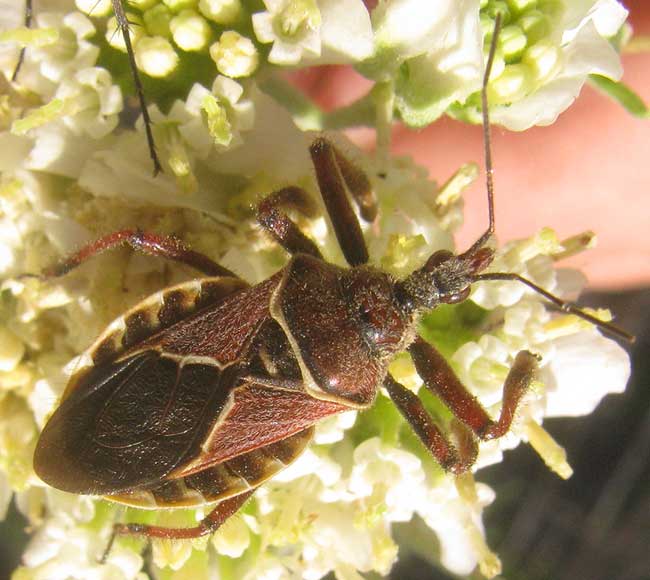Excerpts from Jim Conrad's
Naturalist Newsletter

from the May 11, 2014 Newsletter issued from the Frio Canyon Nature Education Center in the valley of the Dry Frio River in northern Uvalde County, southwestern Texas, on the southern border of the Edwards Plateau; elevation ~1750m (~5750 ft); N29.62°, W99.86°; USA
BEE ASSASSIN
Lounging atop the flowering head of a Woollywhite wildflower, Hymenopappus tenuifolius, was the handsome bug shown above.
And it's truly a "bug," since having that shape, a strawlike, sucking probocis below its head, and wings that are half leathery and half like tissue paper, it's clearly a member of the big "True Bug Order," the Hemiptera. Also belonging to that order are cicadas, aphids planthoppers, and thousands of kinds of somewhat similar-looking species known variously as stinkbugs, shield bugs, and assassin bugs.
Even with so many possibilities, it didn't take volunteer identifier Bea in Ontario long, using the BugGuide.Net browse tab, to write that, "... I did spend some time looking around in the plant bugs and leaf-footed bugs, but these bugs had thick BACK legs and yours has thick FRONT legs, and that detail led me eventually to the assassin bugs and eventually to your Bee Assassin."
So, Bee Assassin, APIOMERUS SPISSIPES.
While confirming the ID I found lots of species looking practically identical to ours, but after reviewing hundreds of pictures and studying the distribution of species possibly found in our area, it seems that Bea probably is right, as usual. Apiomerus spissipes occurs throughout the US, south to central Mexico.
The individual in our picture seems to be waiting for bees coming to take nectar and/or pollen from the flowers. The bees will be "assassinated" when our Bee Assassin thrusts his proboscis into the bee's body and begins feeding. Something interesting that the 110 or so known Apiomerus species do is to apply plant resins to their legs, making them sticky and better able to hold onto bees.
Bee Assassins certainly do kill bees who we like to see pollinating our plants, but studies show that they kill other insects, too, often insects that damage our plants. Therefore, it's unclear whether Bee Assassins do more harm or good in our gardens and cultivated fields. In Nature in general, of course, it's always the case that everything has its place.